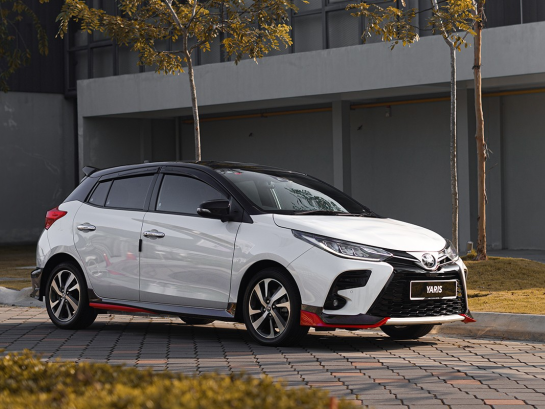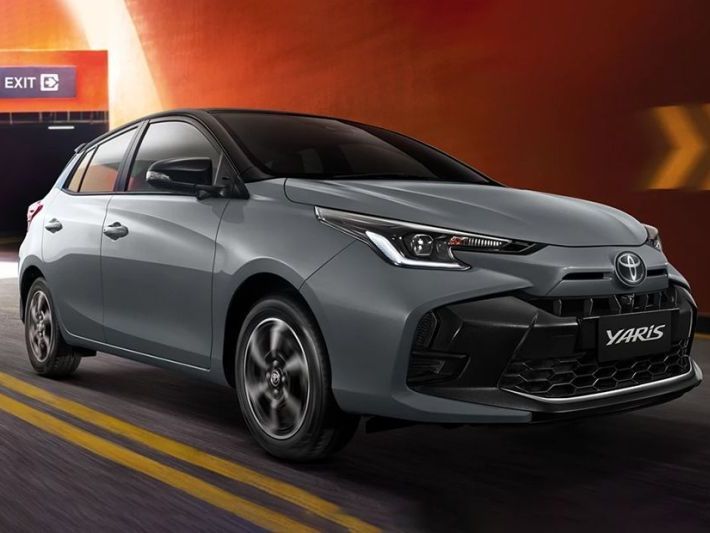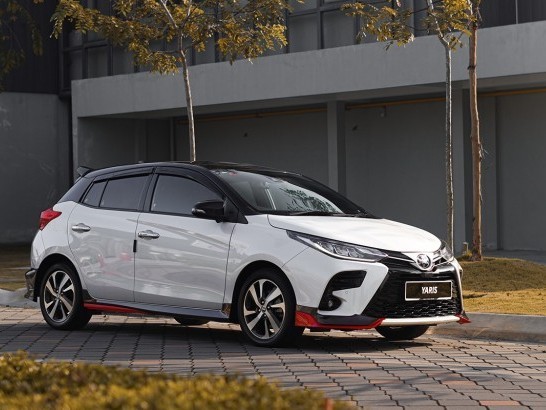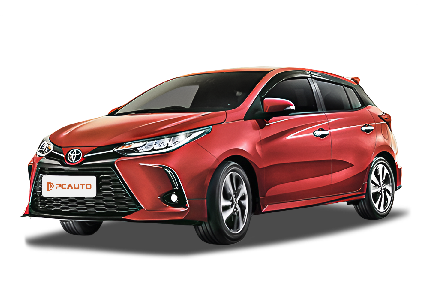Q
What's the Type of Toyota Yaris' Transmission?
The type of the Toyota Yaris' transmission is CVT (Continuously Variable Transmission), which can offer a smooth shifting, effectively reducing the sense of jerk during gear changes and making the driving process more comfortable and stable. Utilizing a belt and variable-diameter pulley system to achieve seamless ratio changes, the CVT keeps the engine operating within its optimal RPM range, thereby improving fuel efficiency.
With 7 simulated gear steps, this transmission adapts to various driving scenarios, providing appropriate power delivery whether in stop-and-go city traffic or during long highway journeys. The system ensures responsive performance across different road conditions while maintaining the inherent advantages of CVT technology.
Special Disclaimer: This content is published by users and does not represent the views or position of PCauto.
Related Q&A
Q
What Segment Does Toyota Yaris Belong to?
The Toyota Yaris belongs to the B-Segment, which is the small car class. Vehicles in this class are relatively compact in size, with a length of around 4140mm, a width of about 1730mm, a height of roughly 1475mm, and a wheelbase of 2550mm. With such dimensions, Toyota Yaris can nimbly navigate through city streets.
Generally,Toyota Yaris is affordable, with price ranging from RM 69,576 to RM 91,600, which is a great option for consumers on a tight budget.
The Toyota Yaris weighs approximately 1110 - 1140kg and is powered by a 1.5L naturally aspirated engine. The power output is more than enough for daily commuting. Inside, it can seat five people. The seats are thoughtfully designed, especially the rear seats, which can be split-folded in a 60:40 ratio, allowing for flexible adjustment of the space for passengers and cargo according to your needs.
Moreover, Toyota Yaris has an advantage in fuel efficiency. It runs on gasoline, and it helps the owners save on fuel costs during daily use.
Q
What's the Reslae Value of Toyota Yaris?
The resale value of the Toyota Yaris is influenced by various factors such as the vehicle's age, condition, mileage, market supply and demand, and vehicle configuration. Generally, the resale value rate of a 3 to 5 years old Toyota Yaris is about 60% to 80%. Take popular models like the 1.5G or 1.5V as an example. If the car is well - maintained and has a reasonable mileage (about 10,000 to 20,000 kilometers per year on average), a 3 - year - old Yaris can still retain about 70% of its original price. Moreover, the high reliability of the Toyota brand and its low maintenance costs are important factors supporting its resale value. It is recommended that car owners perform regular original - factory maintenance and keep complete maintenance records, which will help increase the second - hand resale value. Market conditions may change due to the economic environment and model upgrades. Therefore, for the most accurate resale value estimate, you can refer to the transaction prices of similar models on local used - car dealers or online evaluation platforms (such as Carlist or Mudah) for comparison.
Q
What's the Engine Displacement of Toyota Yaris?
The Toyota Yaris is equipped with a 1.5L naturally aspirated engine (engine displacement: 1496cc), a small yet efficient powertrain that delivers balanced performance and fuel economy, making it ideal for city commuting and daily use. This 1.5L Dual VVT-i engine produces decent torque at low RPMs, paired with a CVT transmission, offering smooth and fuel-efficient driving. The official fuel consumption figures are approximately 5.3 to 5.9L per 100km (varies slightly depending on driving conditions and model specifications).
The 1.5L displacement of the Yaris aligns well with Malaysian consumers' preferences, providing agile urban driving while maintaining low maintenance costs. Additionally, its 1.5L engine size keeps road tax affordable, contributing to lower long-term ownership expenses.
Q
What Engine Is Equipped by Toyota Yaris?
The Toyota Yaris is equipped with a 1.5 - liter (1496cc) in - line four - cylinder naturally aspirated engine, coded as 2NR - FE. It adopts the Dual VVT - i dual variable valve timing technology to optimize fuel efficiency and power output. The maximum horsepower is around 107hp, and the peak torque is approximately 140Nm. It is paired with the Super CVT - i continuously variable transmission. The overall power performance is smooth and fuel - efficient.
This engine emphasizes reliability and economy, making it suitable for city driving. Meanwhile, Toyota's mature technology also ensures low maintenance costs. It can still maintain stable performance in the hot climate and congested traffic conditions in Malaysia.
In addition, although this engine is not high - performance - oriented, it has sufficient low - speed torque and a brisk start. Paired with the CVT transmission, it can achieve a combined fuel consumption of about 5.3 - 5.9L/100km, taking into account both practicality and economy, which meets the needs of local consumers for small hatchbacks.
Q
What’s the PCD Size of Toyota Yaris?
The full English name of PCD is Pitch Circle Diameter, which refers to the pitch circle diameter and is an important parameter of automobile wheels. The PCD sizes of Toyota Yaris models vary across different years. For Toyota Yaris models from 2019 to 2024, their PCD sizes are all 100mm. The PCD size determines the compatibility between the wheel and the vehicle. It represents the diameter of the center circle of the bolt holes on the wheel. If the PCD size isn't appropriate, the wheel won't be properly installed on the vehicle. Understanding the PCD size is crucial when replacing wheels or tires. When choosing suitable modified wheels or spare tires, you need to ensure that the PCD size is the same as the original one of the vehicle. Only in this way can the safety and stability of the vehicle during driving be guaranteed.
Q
Does Toyota Yaris Support Apple Carplay?
Some high - end models of the Toyota Yaris are indeed equipped with multimedia touch display system that supports Apple CarPlay (this depends on the year and model). You can directly connect your iPhone via USB to use functions such as navigation, music, and calls, which enhances driving convenience. However, it should be noted that the entry - level versions may only be equipped with a basic audio system and do not support CarPlay. It is recommended to confirm the specific configuration with the dealer before purchasing a car.
In recent years, Toyota has gradually popularized intelligent connectivity features in many models. Apple CarPlay has become one of the factors considered by many Malaysian consumers before purchasing the vehicle. In addition to CarPlay, some versions may also support Android Auto, allowing users to access their phone functions more flexibly. If your Yaris was made in an earlier year and doesn't have this feature pre - installed, you can also consult the original manufacturer or the authorized service center to see if there is a solution to upgrade the host system.
Q
What's the Brand of Toyota Yaris' Tire?
The brands of original tire equipped by the Toyota Yaris may vary depending on the model year, vehicle grade, and regional dealerships. Common tire suppliers include Bridgestone, Dunlop, or Michelin. The tire specifications are usually 185/60 R15 or 185/55 R16, which are suitable for urban driving (refer to the vehicle configuration sheet for specific details). Tires of these brands focus on wear resistance and low rolling resistance, aligning with the Yaris' economical and practical positioning. Meanwhile, they also offer good wet - road grip, making them suitable for Malaysia's rainy climate.
It is recommended that car owners regularly check the tire pressure and wear. The original recommended tires can ensure optimal fuel efficiency and handling performance. If you need to replace the tires, you can refer to the original specifications on the door frame or in the user manual, or directly consult a Toyota - authorized service center to ensure compatibility.
Q
Is Toyota Yaris a Good Car? Learn the Pros and Cons Here
The Toyota Yaris has its advantages and disadvantages. In terms of advantages, it is equipped with a very rich set of safety features. Standard equipment includes ABS anti - lock braking, vehicle stability control, and seven airbags, which can provide reliable safety protection for both drivers and passengers. Meanwhile, a variety of practical driver assistance systems, such as lane change assist, lane departure warning system, and autonomous emergency braking, are also standard, reducing the risk of accidents. The rear seats in the vehicle are either 60:40 Split - folding or 60:40 Folding seats, allowing for flexible adjustment of the interior space to meet the needs of carrying passengers and cargo. In terms of price, the cost varies among different versions. For example, the 2024 Toyota Yaris 1.5E is priced at RM 88,000, offering a certain range of price options.
However, it also has its drawbacks. The rear brakes of some models use drum brakes, which are slightly inferior to disc brakes in terms of braking performance and heat dissipation. Moreover, in some models, the rear - seat space may not be roomy enough for tall passengers in terms of legroom. Overall, the Toyota Yaris is a vehicle with a high cost - performance ratio that can meet the needs of daily commuting and family use.
Q
What's the Width of Toyota Yaris?
The width of different versions of the Toyota Yaris varies slightly. Generally speaking, the width of the standard version model is 1,730 millimeters, while the width of the Yaris Cross model is 1,770 millimeters. The body width has an impact on the vehicle's handling, stability, and the interior space layout. An appropriate width enables the vehicle to maintain good stability while driving on the road. At the same time, it also determines the size of the interior lateral space, which affects the comfort of passengers. A width of 1,730 millimeters or 1,770 millimeters can well balance the needs of daily driving and interior space.
Q
What's the Road Tax of Toyota Yaris? How to Calculate It?
The road tax of the Toyota Yaris mainly depends on the vehicle's engine displacement. The Toyota Yaris has an engine displacement of 1496cc, which falls into the category of cars with a displacement below 1600cc. For cars with a displacement below 1600cc, their road tax is usually relatively fixed. Generally speaking, the annual road tax is approximately between RM 200 and RM 500. However, the actual road tax may vary due to the policy differences among different states. Road tax is a necessary expense for car maintenance, and car owners need to pay the road tax on time every year to ensure the vehicle can legally drive on the roads. In addition to the road tax, the cost of car maintenance also includes car insurance, fuel costs, parking fees, toll fees, and vehicle repair and maintenance costs. When purchasing a car, it is recommended to consult the dealer clearly about the details of all costs such as the road tax.
Latest Q&A
Q
How big is the gas tank on a GR Corolla 2025?
The 2025 Toyota GR Corolla comes with a 50 - liter fuel tank. This high - performance hatchback is equipped with a 1.6 - liter three - cylinder turbocharged engine and paired with a full - time all - wheel drive system. While offering an excellent driving experience, the 50 - liter fuel tank capacity can also meet the needs of daily commuting and weekend getaways. For Malaysian consumers, the fuel tank design of the GR Corolla strikes a great balance between performance and practicality. Considering the common local driving conditions and the distribution of gas stations, this capacity can support a cruising range of approximately 400 - 500 kilometers (it specifically depends on driving habits and road conditions).
It's worth mentioning that as a model focused on the driving experience, the fuel tank position of the GR Corolla is specially designed to optimize the vehicle's weight distribution, which is also a common practice of Toyota's Gazoo Racing department when developing high - performance models. The hot and rainy climate in Malaysia places higher requirements on the fuel tank material. The GR Corolla uses anti - corrosion coatings and enhanced sealing designs to ensure safe and reliable operation in various environments. If you often drive long distances, it is recommended to regularly check the fuel tank and the oil circuit system, which is especially important in high - temperature and high - humidity environments.
Q
What kind of oil does a 2025 GR Corolla take?
As a high-performance vehicle, the 2025 GR Corolla is recommended to use fully synthetic oil that meets Toyota's original factory standards. The viscosity is typically 0W - 20 or 5W - 30. Specifically, refer to the owner's manual or the advice of local Toyota dealers in Malaysia, as the tropical climate may affect the oil selection. High-performance turbocharged engines have relatively high requirements for oil. Fully synthetic oil can provide better high-temperature protection and anti-wear performance. It is recommended to change the oil every 5,000 to 8,000 kilometers or every 6 months (whichever comes first). Owners in Malaysia need to pay attention to choosing oil with API SP or ILSAC GF - 6A certification. This type of oil is designed for modern engines and can effectively prevent low-speed pre-ignition problems. If you frequently drive aggressively or participate in track days, you can consider using higher-performance racing oil, but for daily use, the specifications recommended by the factory are sufficient. Regular oil changes are crucial for maintaining the performance of the GR Corolla's G16E - GTS 1.6T three-cylinder engine. Meanwhile, it is recommended to use the original factory oil filter to ensure the filtering effect.
Q
What is the difference between a 2025 and 2024 Corolla?
The main differences between the 2025 and 2024 Corolla models are concentrated on the optimization of technological features and the powertrain. The 2025 Corolla is expected to upgrade the Toyota Safety Sense intelligent driving safety system to version 3.0, adding more precise pre - collision warnings and full - speed range radar cruise control. It may also come with a larger center - console touchscreen and support wireless Apple CarPlay/Android Auto, while the 2024 model uses the 2.5 - version system and requires a wired connection.
In terms of power, the 2025 model might slightly improve the overall output efficiency of the 1.8L hybrid system, but it will keep the same 1.8L naturally - aspirated and 1.6L turbo options as the 2024 model. There are minor differences in appearance. The 2025 model may adjust the front grille design and wheel styles.
Malaysian customers should note that the locally - introduced versions may have their configurations adjusted according to market strategies. For example, Southeast Asian specifications often enhance the air - conditioning system and anti - rust treatment for the tropical climate.
As a globally best - selling model, the Corolla's annual iterations are usually based on steady improvements. If you have a limited budget and don't need the latest technology, the 2024 model still offers high cost - effectiveness. Consumers who pursue cutting - edge features can wait for the 2025 model to hit the market and then compare the actual differences between the two models.
Q
Why is the GR Corolla 2025 so special?
The 2025 GR Corolla is special because it inherits Toyota's high - performance genes from Gazoo Racing. It's equipped with a 1.6T three - cylinder turbocharged engine that can churn out over 300 horsepower. And it comes with the GR - Four all - wheel - drive system, which provides flexible power distribution, offering an exhilarating driving experience. It's especially suitable for Malaysia's winding mountain roads and race tracks.
This car also features a lightweight body and a sport - tuned suspension, ensuring precise handling. The limited - edition Morizo Edition further enhances its exclusivity. For Malaysian car enthusiasts, the GR Corolla is not just a high - performance hot hatch; it represents Toyota's commitment to pure driving pleasure. Its arrival allows those with limited budgets to experience the thrill similar to that of a rally car.
Moreover, it has great potential for modification. Given the strong local car - modifying culture, there's plenty of room for future upgrades. Whether it's for daily commuting or track days, the GR Corolla can handle it all. It's an ideal choice that combines practicality and performance.
Q
What is the top speed of the 2025 Toyota Corolla GR?
In 2025, the top speed of the Toyota Corolla GR is expected to reach approximately 225 to 235 kilometers per hour. The specific figures may vary due to different market tuning or configurations. This performance - oriented model is equipped with a 1.6 - liter three - cylinder turbocharged engine with a maximum power of about 300 horsepower. It also comes with the GR - Four all - wheel drive system and a 6 - speed manual or 8 - speed automatic transmission, offering drivers a precise handling experience.
For car enthusiasts in Malaysia, the Corolla GR not only inherits the practicality of the regular Corolla but also shows excellent dynamic performance on local winding roads or high - speed sections through its strengthened chassis, sporty suspension, and exclusive aerodynamic kits.
It's worth noting that high - performance hatchbacks need attention on heat dissipation and tire selection in hot climates. Regular maintenance is recommended to ensure the engine and cooling system are in optimal condition. Meanwhile, Malaysian owners can refer to the adaptation tuning suggestions provided by UMW Toyota. Usually, these models require higher - grade fuel to unleash their full potential.
View MoreRelated News

Toyota Yaris Interior Design Revealed: The Ideal Choice for Daily Commutes
AshleyJul 17, 2025

Highlights of the Toyota Yaris: The Perfect Fusion of Outstanding Power and Comfortable Handling
MichaelApr 16, 2025

Is my Yaris fuel consumption normal? What should the fuel consumption per 100km be?
MichaelFeb 28, 2025

Toyota takes the crown at the second stop of the 2025 WRC, the GR Yaris helps Toyota take the top of the points table
JamesFeb 19, 2025

Starting from RM 88,000! The favorite of office workers, Toyota Yaris meets all your needs!
LienSep 4, 2024
View More


















Pros
Cons